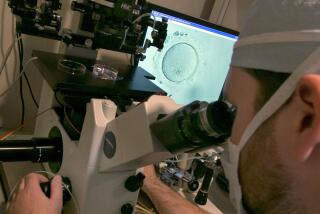When tinkering with our DNA, researchers should take it slow
The manipulation of human genes could lead to profound advances in our ability to cure or prevent terrible diseases. But in some cases, it might also mean introducing genetic material that could be passed from one generation to the next, changing the human gene pool in a manner that could inadvertently harm peoplesâ health.
Such âinheritableâ DNA is a hotly debated issue among bioethicists, and one that an advisory committee of the Food and Drug Administration will review Tuesday and Wednesday as it considers whether human trials should be allowed for a new therapy that could prevent a rare but devastating inherited disorder.
Mitochondrial disease involves the specialized compartments within human cells that are responsible for creating most of the energy needed by the body. When a personâs mitochondria are faulty, the resulting disorder can be disabling or fatal, with symptoms that can include loss of motor control, muscle weakness and pain, cardiac or liver disease, seizures, respiratory difficulty and susceptibility to infection. It is passed on to a child through the motherâs mitochondria.
Researchers working with animals have devised a possible solution. A donor egg with healthy mitochondria is used, but the nucleus is removed and replaced with the nucleus from an egg of the afflicted mother; the egg is then fertilized in vitro. Because all but a minuscule amount of human DNA is contained in the nucleus, the child would be almost entirely the genetic offspring of the original couple. But because a bit of genetic material comes from the donorâs mitochondria, the procedure is sometimes called âthree-parent IVF.â
The procedure is intended to allow afflicted women to bear healthy children who could have their own children and grandchildren without the need for such a procedure. If approved, it would be the first time scientists were changing the genetic material of humans in a way that could be passed down through the generations.
The European Union takes a dim view of research that aims to change the genes of future generations. Although researchers in Oregon successfully produced several rhesus monkeys using the mitochondrial procedure, an attempt to use the same process to create human embryos resulted in half of the eggs undergoing abnormal fertilization. Such embryos would certainly not have been implanted in a human trial.
Critics also point out that the monkeys born through the procedure have not yet reproduced or lived out their life cycles. What if problems show up later in their lives, or in their offspring?
Considering these caveats, it seems far too early for the FDA to even consider allowing human trials. But it should encourage researchers to continue exploring the keys that might unlock gene-based cures. It is vital to proceed with extreme caution on research that involves possible permanent changes in the human genome, but it also would be a shame to shut off all hope of preventing suffering because of possibly unfounded fears about gene-based cures.
More to Read
A cure for the common opinion
Get thought-provoking perspectives with our weekly newsletter.
You may occasionally receive promotional content from the Los Angeles Times.










